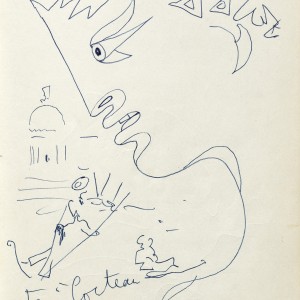On view over 150 artworks that have as common denominator the versatility of the artist
With “Jean Cocteau - The Juggler’s Rematch,” the Peggy Guggenheim Collection offers over 150 artworks that have as their common denominator the incredible versatility of the artist. An early writer (at the age of twenty, he published his first collection of poems) and skilled caricaturist, he was able to capture on paper, with a few agile pencil strokes, a character, a situation, a personality. This skill would never abandon him and can be appreciated even in the artworks realized in the second part of his career, as in the Untitled piece dated 1956 on view.
In the sheet on the right stands in the foreground a stylized profile with classic features: the head of a Greek god, of a glorious leader, or perhaps of a poet, who seems surrounded by a laurel wreath, while in the background, just sketched, appears the profile of an ancient temple, topped by a round dome. But you could also see in the dome a vague reference to more than a few Venetian churches and in the face the effigy of an ancient warrior victor. After all, Venice is a city much loved by Cocteau, where he also frequented Peggy Guggenheim, who was introduced to him by Marcel Duchamp.
IN THE EXHIBITION, ALSO MASQUE POUR LA PIÈCE ANTIGONE AND THE MIRROR OF ORPHEUS TO WITNESS HIS ATTRACTION TO MYTHOLOGY
As a child, Cocteau was also fascinated by theatre, for which he wrote original works and adaptations. As a director, he left his mark directly on the stage, attracted by the charm of costumes (especially masks). In 1923, he made Masque pour la pièce Antigone, assembled with poor materials: a wire mesh, a pipe cleaner, and beads. Multifaceted sensitivity, strongly imbued with a classic taste, Cocteau was also irresistibly attracted to mythology. An example is The Mirror of Orpheus (1960-’89). We see the faces in profile, facing each other, prostrated in the tension of an imminent kiss, a triumph of love over death. A kiss, however, destined not to be fulfilled: the lips remain suspended in the void, close but detached forever, and the heads inscribed in the enigmatic round frame of a mirror reveal themselves covered by masks.
THE MIRROR AS A DOOR TO THE AFTERLIFE IS A RECURRING THEME IN HIS WORK
The mirror as a door to the afterlife is a recurring theme in Cocteau’s work, as in the 1950 film adaptation of the myth of Orpheus, set in post-war Paris. Cocteau then reinvents the classic myth and at the same time gives scandal. Consider Fear Gives Wings to Courage, exhibited for the first time in 1938 in the Guggenheim Jeune gallery in London. The drawing was even seized by British customs because it was considered immoral (the pubic hair of three figures is visible). For this reason, after recovering the work, Peggy Guggenheim decided never to exhibit it in public again.
The Cocteau eclecticism—juggler of the arts (“weapons loaded with the future,” paraphrasing a famous quote attributed to him)—is finally summarized by Philippe Halsman’s photo of 1949, which is, in a sense, the leitmotif of the entire exhibition. The subject—Cocteau himself—as in a futurist shot that captures the action in the visual space, decomposing the individual frames, is caught in a frantic movement and seems to swirl his arms, intent on making different actions: writing, holding a book, bringing a cigarette to his mouth, painting. A joyful joke of the “juggler artist” and, nevertheless, extremely rigorous: probably this is the sense of revenge on those who, contemporary to him, may have doubted his ability to establish himself in different artistic fields. Like a six-armed mythological figure, he seems to have managed to achieve what is impossible for an ordinary mortal.





























